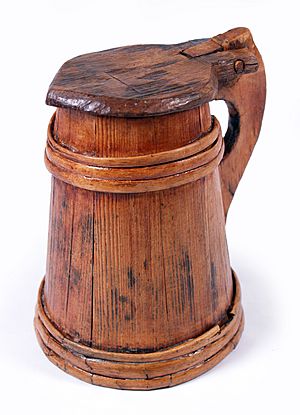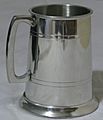Tankard facts for kids

A tankard is a special kind of drinking cup. It's usually big and shaped like a cylinder, with one handle. Tankards are often made from silver or pewter. But you can also find them made from wood, ceramic, or even leather. Some tankards have a lid that opens and closes. Others have a clear glass bottom. They look and are used a lot like beer steins.
Contents
Tankards Through Time
Wooden Tankards
The word "tankard" first meant any container made of wood, way back in the 1200s. Later, it came to mean a drinking cup. The very first tankards were made from wooden pieces, much like a barrel. These early ones did not have lids. An old wooden tankard, about 2000 years old, was found in Wales. It could hold about four pints of liquid!
Glass Bottoms
Many metal tankards have a glass bottom. There are a few interesting stories about why this is.
One story says that glass-bottomed tankards helped people avoid being forced into the British Army or Navy. This was called "conscription." The idea was that if a coin was dropped into your drink, you could see it through the glass bottom. Then you could refuse the drink and avoid being forced to join. However, this is probably just a myth. The Navy could simply force people to join, so tricks weren't really needed.
Another story suggests the glass bottom was for safety during a bar fight. If someone was about to hit you, you could see them coming while you were drinking!
A simpler idea is that the glass bottom just let drinkers see how clear their drink was. It also saved money because a full glass pint was more fragile and expensive.
Sometimes, new glass bottoms are added to old tankards. This can make the antique tankard less valuable and not truly original.
Modern Tankards
Today, metal and ceramic tankards are still made. But they are usually seen as special or unique items. Modern metal tankards are often engraved with messages to celebrate special events.
Glass tankards are also very common. These are glass cups with straight or slightly sloped sides and a handle. People still use them every day.
Pewter and Health
In the past, the pewter used to make tankards often contained lead. Drinking from these could cause health problems, like gout. This was especially true in places where people drank a lot of cider, like Somerset in the UK. The acid in the cider would pull the lead out of the pewter faster. Because of this, clay tankards became more popular in those areas. Luckily, most pewter today is made without lead.
Tankards in Pop Culture
In the 1970s, a TV advertisement for Whitbread beer showed a pub landlord telling a tall story to an American tourist. The tourist then asks, "Are you really Lord Tankard?" This shows how tankards were part of everyday life and stories.
Gallery
-
A white slipware tankard from Cyprus, around 1600–1150 B.C.
-
A wooden tankard shown in the coat of arms of Honkajoki, Finland.
ca:Xop (atuell) it:Boccale
See also
 In Spanish: Pichela para niños
In Spanish: Pichela para niños







